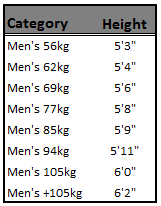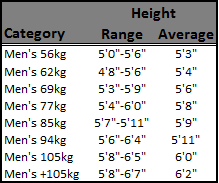Dip N' Drive
The Sport of Weightlifting
Old School Weightlifting
Posted by on February 24, 2014
Found old video surfing around YouTube. 1970 European Weightlifting Championship:
Hookgrip: Bar Acceleration in Second Pull
Posted by on February 21, 2014
Hookgrip has been doing amazing work lately. Their Facebook and Instagram pages are constantly churning out beautiful weightlifting photography.
Lately they’ve been doing more “infographic” photos that provide insight in addition to beauty. Below is the best example to date:
The lines track bar path for three world-class 77kg weightlifters cleaning 196kg. The length of each line segment represents distance traveled between each frame.
Two things you can notice about Lu Xiaojun’s photo compared to the other two.
1) Look at how much more vertical Lu’s bar path is than the other two lifters. You can also see this in his lack of lean back relative to the other two lifters at triple extension.
2) Look at how much power Lu generates during his second pull. As hookgrip notes, it “show[s] Lu’s remarkable explosive power even compared to the best 77s in the world”.
Interview with OTC Resident Zach Krych
Posted by on February 20, 2014
At the beginning of January, Barbell Shrugged did an interesting 83 minute video interview with National Champion and Olympic Training Center resident Zach Krych.
Zach is an 85kg weightlifter who has come back from a bad injury in 2009.
World Record Weightlifting Totals In Their Weight Categories
Posted by on February 19, 2014
Simple post today. All the current World Record totals.
Height and Bodyweight
Posted by on February 18, 2014
Weightlifting requires muscles. Here are pictures of the Gold medalists in the 56kg, 62kg, 77kg, 105kg, and 105+kg weight classes at the 2013 Worlds. None of those guys is skinny, lanky, or lithe.
So what weight class do you need to get to at a given height? The following chart uses the data from All Things Gym and their post on London 2012 Weightlifting Athletes Statistics. It averages the heights for all 158 weightlifting athletes at the 2012 Summer Olympics in London.
While these are ideals, they’re not going to hold for less elite lifters. A local weightlifter is not going to be as thin and muscular as Lu Xiaojun. Even within the London data set, there is wide variety.
At 5’9″ I should be smack dab in the middle of both the 77kg class and the 85kg class. Right now, I’m about 83kg. I need to gain another 10 pounds to get the most out of my height (more specifically lose ten pounds and gain twenty). Very tall lifters won’t get the most out of their longer levers without gaining significant weight (105kg is 231 pounds). I have a client who is 6’3″ 185″ and he’s just too lanky to really feel comfortable weightlifting, at least for now.
Dmitry Klokov Videos
Posted by on February 17, 2014
Dmitry Klokov is a Russian 105kg weightlifter. He started getting a following the CrossFit community, especially from Outlaw’s Rudy Neilsen, who penned a love note to the Russian. His YouTube channel was full of original, creative training videos completely different from the ordinary weightlifting training videos.
Klokov capitalized on his new found Internet fame by going on a global tour doing wildly popular weightlifting seminars. At $500 a pop, this must have been a lucrative trip. Many US weightlifters complain about the lack of financial support for weightlifters compared to other countries. Creative entrepreneurship like this may be able to fund a full time weightlifting career.
Here are a few of my favorite Klokov videos. There are plenty more.
Warm-Ups
Legs
Core
Panda Pulls
Posted by on February 14, 2014
Not like this. Like this:
I only recently discovered this “Chinese” version of the classic high pull, also called ‘Fast Pulls’, and have never heard them mentioned by a coach. So why do them? I did some Googling around and here’s what I found:
Panda pulls are done to reinforce the reality that Olympic weightlifters have to violently pull themselves underneath of a free falling barbell — that’s why there’s an extreme downward recoil. (Source)
1. To ingrain the actual hip extension technique.
2. To minimize bar drop
3. To stimulate the muscles and CNS further
(Source) with much more detail about the three reasons
The “Panda Pull” allows [beginner] lifters to perform the pulls as they would during a classic lift (with proper technique and coordination) at a higher weight without having to worry about finishing the lift. As far as intermediate and elite level lifters are concerned, you can expect to perform this exercise with well more than 100% of your top snatch and clean & jerk. (Source)
Chinese Training at 2013 World’s
Posted by on February 13, 2014
Lu Xiaojun and Liao Hui (China, 77 and 69, respectively) doing a little light training after arriving in Wroclaw, Poland, for the 2013 Worlds.
I always enjoy watching videos of the very best lifters during training. You can pick up a lot of little things from watching them in a natural environment like this. With that said, take anything you see someone at this level doing with a huge grain of salt. For someone like me, for instance, it’s not really relevant how Lu Xiaojun trains as a world record holder. I’m sure he didn’t train this way before he even had a bodyweight snatch.
So how did the 2013 Worlds go for these two amazing lifters?
Lu Xiaojun set the Snatch and Total world records @ 77kg with 176kg Snatch, 204kg Clean and Jerk, and a 380kg Total:
Liao Hui set the Clean and Jerk and Total world records @ 69kg with 160kg Snatch, 198kg Clean and Jerk, and a 358kg Total:
USAW Sports Performance Certification, Part 1
Posted by on February 12, 2014
I took the USAW Sports Performance Certification Class over Super Bowl weekend, at Reebok One in NYC. There were ten Reebok One trainers with varied past experience with the lifts, a CrossFit guy and me. The facility was a four or five story gym with classes, courts, all manner of machines, free weights, a cafeteria and more. It was a great space to use with plenty of room to work.
The instructor broke the two days into four sections: (1) classroom time Sat AM (2) barbell time Sat PM (3) barbell time Sun AM (4) classroom time Sun PM. Saturday morning lasted from 8:30 to 1:00 and covered all the written material on the lifts themselves, including why and how we do them. There was plenty of discussion among the group and the instructor let us talk freely. Saturday afternoon meant practical work with a bar in our hands. From 1:30 to 5:45 we warmed up, reviewed progressions of the three lifts, and took our clean (no jerk) to a max for the day, while the instructor and his assistant coached and corrected us. Sunday morning was 8:30 to noon and covered the squatting, pulling and pressing exercises, though nothing heavier than 50%. We also had a ‘practical review’ where each of us coached someone else on one of the three lifts. Sunday afternoon we talked program design, and reviewed and took the test. The test is nothing to worry about. You should pass without a problem. The instructor makes certain that you are prepared.
Instructor Mike McKenna is this one, not this CrossFit one. Funny and friendly, he had a ton of stories to share about recent or past weightlifting history relevant to the point at hand. There was lots of discussion during the classroom times and plenty of back and forth on the hows and whys. His opinions flowed freely about the various characters of the wider weightlifting world. The only one I will share is his recommendation of Spencer Arnold as the best of the free online programming to follow. He prepared us well for the test, emphasizing the critical issues, and I felt confident while taking it.
After this class, I feel much more comfortable introducing my clients to weightlifting. Like any certification, it doesn’t mean you’re magically a capital-C Coach. But it sets you up with the tools for success to spread the gospel of weightlifting to the masses safely and effectively.
For instance, to get the boxer I train doing power cleans, the stated progression is:
- Front Squat
- Power Clean from Power Position
- … from Hang Above Knee
- … from Below Knee
- … Lift Off (going from setup to the knee)
- … from Floor
Getting him to master those positions, first with an empty bar and slowly with added load, should set him up to move well and not ingrain any bad motor patterns. I wouldn’t have known how to approach this before, and probably would have had him doing crappy power cleans, slowly correcting each mistake one by one. The progressions ensure that everything is in place and I can focus on fewer mistakes at a time.
As an individual lifter, I felt the course was helpful, but not necessary. However as an aspiring coach, the course is a great foundation for teaching the lifts.
Upcoming Meets
Posted by on February 11, 2014
March 9 New England States Open Enfield, CT
March 16 NYC Open Garden City, NY
April 13 CF Trimountain Durham, CT
June 1 CF True Athletics Hamden, CT
Unrelated Video: Clean and Jerk Box Jumps





Recent Comments